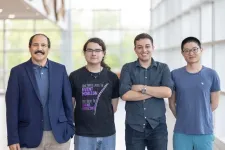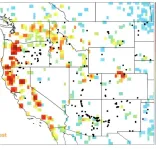(Press-News.org) Dr. Mustapha Ishak-Boushaki, a theoretical astrophysicist at The University of Texas at Dallas, has spent his career seeking answers to some of the universe’s greatest mysteries, including why the expansion of the universe seems to be accelerating and whether gravity behaves differently beyond our closest cosmic neighbors.
To study these and other questions, a large collaboration of scientists, including Ishak-Boushaki and UTD physics doctoral students Cristhian Garcia Quintero, Leonel Medina Varela and Yunan Xie, are using data from the Dark Energy Spectroscopic Instrument (DESI) to map more than 40 million galaxies, quasars and stars. On June 13, the collaboration publicly released its first batch of data, with nearly 2 million objects for researchers to explore.
Spectroscopy is a technique that uses light from objects such as stars and galaxies to determine their physical properties, including chemical composition, distance and relative motion. DESI, a ground-based instrument at Kitt Peak National Observatory in Arizona, uses 5,000 robotic positioners to move optical fibers that capture light from objects millions or billions of light-years away. It is the most powerful multi-object survey spectrograph in the world, able to measure light from more than 100,000 galaxies in one night.
As the universe expands, it stretches light’s wavelength, making it redder — a characteristic known as redshift. The farther away the galaxy, the bigger the redshift. DESI specializes in collecting redshifts that can then be used to solve some of astrophysics’ biggest puzzles, such as what dark energy is and how it has shaped the structure and evolution of the universe.
The newly released 80-terabyte data set comes from 2,480 exposures taken over six months during the experiment’s “survey validation” phase in 2020 and 2021.
“With this data, we are creating a very precise, 3D map of objects in the universe, with a high degree of certainty where they are in space,” said Ishak-Boushaki, professor of physics in the School of Natural Sciences and Mathematics. “This is not possible with other observational methods, such as visual imaging.”
DESI is two years into its official five-year run and ahead of schedule on its quest to collect more than 40 million redshifts. The survey has already catalogued more than 26 million astronomical objects in its science run and is adding more than a million per month.
Today the collaboration also published a set of papers related to the early data release that include early measurements of galaxy clustering, studies of rare objects, and descriptions of the instrument and survey operations. The new papers build upon DESI’s first measurement of the cosmological distance scale that was published in April, which used the first two months of routine survey data and also showed DESI’s ability to accomplish its design goals.
“The quality of this first two months of data is astonishing,” said Ishak-Boushaki, who is co-chair of the collaboration’s Cosmology Parameter Estimation working group, one of several specialized groups that are analyzing various aspects of the data. He, along with Garcia Quintero and Varela Medina, are co-authors of several of the new papers that describe the use of DESI data to detect the baryon acoustic oscillation signal. This signal shows how clusters of ordinary matter, called baryons, which formed shortly after the Big Bang, created an imprint where future galaxies and clusters of galaxies formed.
Much of Ishak-Boushaki’s research centers on confirming one of Albert Einstein’s most significant contributions to modern physics: the general theory of relativity. General relativity, which is a description of gravity, has two aspects that can be tested: how matter and light move in the universe.
“Although general relativity has been confirmed in our solar system and nearby stars, at the level of cosmology — the largest scales in the universe — it has never been tested with high precision and has not been confirmed,” Ishak-Boushaki said. “It could be different at cosmological scales. DESI will tell us how matter moves in the universe so we will be able to test general relativity to an unprecedented precision.”
Insight from DESI into general relativity also could shed light on cosmic acceleration, the observation that the expansion of the universe is speeding up. Cosmic acceleration is problematic because it counters how gravity, which causes objects with mass to be drawn together, is observed to work in our solar system and nearby space.
Ishak-Boushaki, his students and many other astrophysicists are exploring possible explanations, including the effects of dark energy and dark matter, as well as the nature of gravity at large scales.
“Maybe at cosmological scales, general relativity changes into another theory, or there is a modification to it,” Ishak-Boushaki said. “DESI is the chief experiment that could give us an answer.”
The DESI collaboration includes more than 450 researchers from over 70 institutions worldwide. The Department of Energy’s (DOE) Lawrence Berkeley National Laboratory manages the experiment. In addition to the DOE, DESI is supported by the National Science Foundation, the Science and Technology Facilities Council of the United Kingdom, the Gordon and Betty Moore Foundation, the Heising-Simons Foundation, the French Alternative Energies and Atomic Energy Commission, the National Council of Science and Technology of Mexico, the Ministry of Science and Innovation of Spain, and DESI member institutions.
END
DESI data sheds more light on 3D map of cosmos, study of universe
2023-06-14
ELSE PRESS RELEASES FROM THIS DATE:
Under the weather: Scientists should spend more time in the rain
2023-06-14
Scientists need to get out of the lab and into the rain, say an interdisciplinary group of researchers led by John T. Van Stan of Cleveland State University. Writing in the journal BioScience, the authors make the case that human observation of storm events (be it rain, snow, or occult deposition) is key to understanding wet weather and its myriad effects on the natural world.
Recently, Van Stan and colleagues noted a trend in the scientific community towards relying on remote ...
Gene provides clues for preventing common diabetes side effect of corticosteroid treatment
2023-06-14
A study led by researchers at the Garvan Institute of Medical Research shows for the first time how a gene called RELA, known to regulate inflammation, also plays an essential role in maintaining normal blood-sugar levels.
The findings, published in Diabetologia, have implications for the prevention of steroid-induced diabetes, a temporary form of diabetes that affects up to half of hospital patients treated with high-dose steroids.
“Our discovery sheds new light on a complex network of factors governing glucose metabolism and how it can go awry in diabetes,” says Professor ...
How prescribed burns could limit megafires in California, Oregon, and Washington
2023-06-14
Wildfire smoke is a threat to air quality, public health, and ecosystems throughout the U.S. Notwithstanding the impact of this year’s Canadian wildfires, the West typically sees much higher exposure to wildfire smoke than other regions of the country. New research from Harvard University, the U.S. Forest Service, and National Oceanic and Atmospheric Administration indicates that controlled burns – particularly in coastal areas of northern California and the Pacific Northwest – could dramatically reduce the overall amount of wildfire smoke exposure in vulnerable rural communities and dense ...
Specialty drugs accounted for most new product launches in the past decade. Why do we know so little about how clinical studies influence their diffusion?
2023-06-14
Researchers from McGill University and Ontario Tech University published a new Journal of Marketing article that examines the drivers of specialty drug diffusion.
The study, forthcoming in the Journal of Marketing, is titled “Scientific Evidence Production and Specialty Drug Diffusion” and is authored by Demetrios Vakratsas and Wei-Lin Wang.
A notable trend in the pharmaceutical industry is the development of specialty drugs to treat complex, severe diseases, often with a limited number of patients. Of the 219 new drugs (or new active substances, NASs) that were launched in the U.S. between 2014 and 2018, 136 ...
NCCN debuts roadmap for improving thyroid cancer care in low- and middle-income countries on world stage
2023-06-14
PLYMOUTH MEETING, PA and LONDON, UK [June 14, 2023] — The National Comprehensive Cancer Network® (NCCN®) is introducing a new global resource to improve thyroid cancer care in low- and middle-income countries at the upcoming World Congress on Thyroid Cancer, in London. During the event, NCCN Senior Vice President and Chief Medical Officer, Wui-Jin Koh, MD, will present on NCCN’s ongoing global work to define and advance high-quality, high-value, patient-centered cancer care. As part of ...
Alcohol harm reduction can also reduce other substance use
2023-06-14
SEATTLE, Wash. – Quitting alcohol or drugs was not a top priority for people experiencing homelessness in a harm reduction treatment study, yet participants still reduced their use of both.
A different approach than traditional abstinence-based programs, harm reduction treatment for alcohol use disorder, also called HaRT-A, has patients set their own goals. In a study of 308 people experiencing homelessness, the participants receiving harm reduction treatment set goals of meeting basic needs and improving quality of life well above quitting alcohol and other substances.
Yet harm reduction treatment still led to more reduced use compared to a control group who received ...
New state-of-the-art robotics lab to be created at Maynooth University
2023-06-14
The Maynooth University Foundation is delighted to announce a significant donation from Intel Ireland to support the creation of a state-of-the-art robotics lab. The lab will provide MU students with invaluable hands-on learning experiences using cutting-edge robotic technologies.
The establishment of the robotics lab at a total cost of €150,000 will equip Maynooth University students with access to innovative robotic technologies and equipment used by engineers from Intel and other companies. This hands-on experience will enable them to bridge the gap between classroom learning and real-world application, empowering them to develop and refine their skills in robotics.
The ...
Inhaled beta-2 agonists are not associated with a lower risk of Parkinson’s disease
2023-06-14
Beta-2 agonists are bronchodilators commonly used in the treatment of asthma and chronic obstructive pulmonary disease (COPD). Although beta-2 agonists have been associated with a reduced risk of Parkinson’s disease in some previous epidemiological studies, this association was not found in a recent register-based study from the University of Eastern Finland. The findings were published in Clinical Epidemiology.
Accumulation of the alpha-synuclein protein in the brain plays a central role in Parkinson’s ...
Slightly lost bumblebees use scent to find their way home
2023-06-14
Put yourself in the exoskeleton of a bumblebee for a moment: your world would be a riot of colors and scents, both essential to guide your search for pollen and nectar. Bumblebees have excellent vision: they have a pair of compound eyes that can distinguish UV and most colors except red, plus three additional simple eyes specialized in detecting polarized light. Their sense of smell dwarfs ours: approximately 100 times more sensitive, and capable of sniffing out illegal drugs or explosives at airports, confirming pregnancy in women, or detecting cancers and diabetes in early-stage patients.
Now, ...
New way of identifying proteins supports drug development
2023-06-14
All living cells contains proteins with different functions, depending on the type of cell. Researchers at the University of Gothenburg have discovered a way to identify proteins even without looking at their structure. Their method is faster, easier and more reliable than previous methods.
Currently, the general view is that each protein’s structure is what controls its function in cells. The atomic sequences, meaning how the atoms are arranged in the proteins, create the protein’s structure and shape. But there are many proteins that lack a well-defined structure.
Researcher Gergely Katona ...




